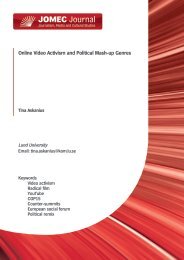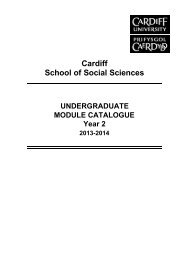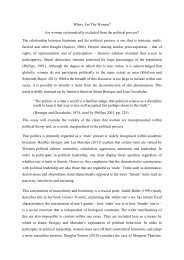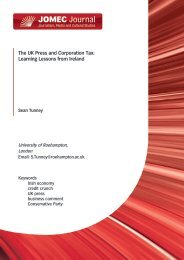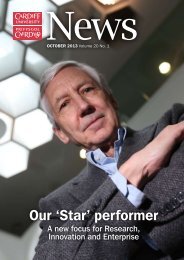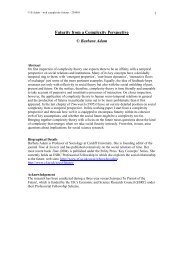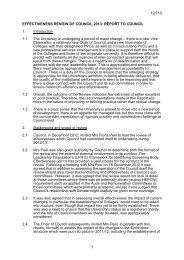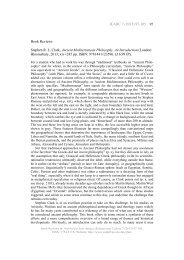APHRODITE IN PROCLUS' THEOLOGY - Cardiff University
APHRODITE IN PROCLUS' THEOLOGY - Cardiff University
APHRODITE IN PROCLUS' THEOLOGY - Cardiff University
You also want an ePaper? Increase the reach of your titles
YUMPU automatically turns print PDFs into web optimized ePapers that Google loves.
JLARC 3 (2009) 21-43 29<br />
Both Hermes and Aphrodite are unifying principles in the world according to<br />
Proclus, Hermes “takes part in the making of the daily and nightly phenomena and<br />
masculinizes and feminizes itself,” while Aphrodite participates in the creative acts<br />
of the solar monad “for she has the ability to bind and adjust that which has been<br />
separated.” 33<br />
Proclus says that Aphrodite unifies and leads Hermes’ and Helios’ actions to a<br />
communion, and gives harmony to that which is in the one careless (ἀνειμένην)<br />
and in the other stretched (ἐπιτεταμένην), whatever these qualities may mean for<br />
Hermes’ and Helios’ demiurgy. 34 Proclus describes Sun’s celestial companions as<br />
a cosmic image of the noetic triad:<br />
In Tim. 3.66,13-24: καὶ μήποτε ... ταῖς πρώταις τρισὶ μονάσι ταῖς ἐν προθύροις<br />
τἀγαθοῦ προῆλθον ἀνὰ λόγον ὁ μὲν γὰρ ἥλιος, ὡς ἐμάθομεν ἐν Πολιτείᾳ , τῆς<br />
ἀληθείας εἰκόνα τὸ φῶς ὑπέστησεν, ἡ δὲ Ἀφροδίτη κάλλους ἐστὶν αἰτία τοῖς<br />
γενητοῖς, ὅ ἐστιν ἐκείνου μίμημα τοῦ κάλλους, ὁ δὲ Ἑρμῆς συμμετρίας πᾶσιν<br />
αἴτιος λόγος ὢν τοῖς περὶ τὴν γένεσιν· πᾶσα γὰρ συμμετρία καθ’ ἕνα πρόεισι λόγον<br />
καὶ κατ’ ἀριθμόν, ὧν ἐστιν ὁ θεὸς οὗτος δοτήρ. ἐκείνων οὖν τῶν μονάδων ὄντες<br />
ἀνὰ λόγον μετ’ ἀλλήλων οὐσῶν εἰκότως καὶ αὐτοὶ συνεῖναι ἀλλήλοις ἐφίενται<br />
καὶ συμπεριπολεῖν.<br />
Perhaps these stars have appeared into the cosmos in analogy with the first three<br />
monads ... these monads we find at the vestibule of the good (a reference is to<br />
Plato's Philebus 64c). 35 And indeed, as we have learned from the Republic (VI<br />
508b12) the sun produces the light as a likeness of truth, and Aphrodite is the cause<br />
of beauty for the beings in cosmos and the copy of the beautiful beings in the<br />
noetic triad. Calculating Hermes is the cause of proportion for all beings in the<br />
world of becoming ... Like the sun, Aphrodite and Hermes are also analogous to<br />
these mutually unified monads and because of this they also want with justice to<br />
come together and create their cycle in concert (translation mine).<br />
Since Proclus returns to the analogy of the cosmic world and intelligible triads<br />
in other passages, 36 it is clear that the correspondence is not for him a casual result<br />
of exegetic zeal.<br />
In this same place in the Commentary on the Timaeus, 37 where the main issue<br />
to be dealt with is the world’s body, Proclus explains that the planetary deities are<br />
32 In Remp. 2.59,1.<br />
33 In Tim. 3.65,5-8. Aphrodite was represented in some statues also with beard; cf. William<br />
Sale, “Aphrodite in the Theogony,” Transcations and Proceedings of the American Philological<br />
Association 92 (1961), pp. 508-521. Proclus associates hermaphroditic traits only to Hermes.<br />
34 In Tim. 3. 67.<br />
35 It is not quite obvious where Proclus situates the vestibule of the Good. On the grounds of<br />
similarities in this passages and Theol.Plat. 3.64,8-12 I am inclined to think that he means the last<br />
term of the noetic triad which is characterized by the monads of symmetry, truth and beauty.<br />
36 In Tim. 3.69, 5-69, 14.<br />
37 In Tim. 3.69,15-27.<br />
Tuomo Lankila, ‘Aphrodite in Proclus’ Theology,’ in: Journal for Late Antique Religion and<br />
Culture 3 (2009) 21-43; ISSN: 1754-517X; Website: http://www.cardiff.ac.uk/clarc/jlarc





